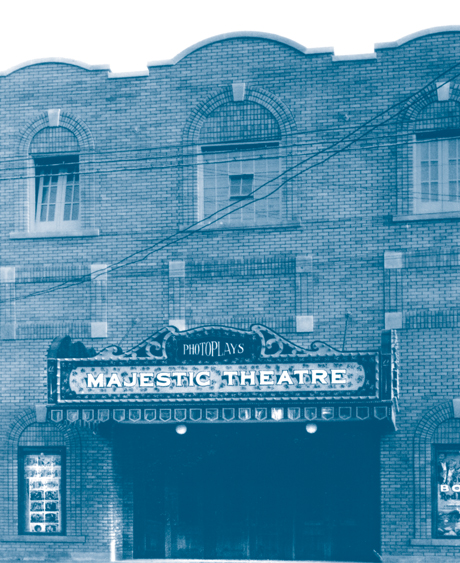A late entry in the neighbourhood cinema landscape, the Hyland on King East near Mary opened about 1959 and ran for a quarter-century before closing.
This at one time was the Odeon Twin now its new life as a pawn shop is light years from silver screen fantasies
For a week in late August, a sleepy stretch of Hamilton’s Barton Street was unusually active and vibrant. Dusty storefronts were cast into sharp relief by stern lighting rigs – as were upturned cars, crumpled and charred by set designers as part of a location shoot for a Steven Spielberg-produced TV pilot. In the middle of all the meticulous destruction and local gawkers, one cameo might have escaped notice. Only a darkened second-storey neon sign gave 758 Barton Street East away as the former home of the Towne Cinema, one of a handful of neighbourhood cinemas once located nearby, and one of many all but forgotten today.
In the golden days of movies – the 1930s and ’40s – Hamilton’s movie-going public was served by over 20 motion picture theatres. Hamilton had six major palaces downtown and 15 neighbourhood or "second run" theatres scattered across the lower city, ranging from small (400 seats) to medium (800 seats) and large (2,000 seats and up). In the ’30s, the popularity of movies owed something to the Depression. In the days before television, they were a popular diversion. Hard times saw moviegoers escape indoors to watch the hapless rich in romantic comedies, westerns and crime dramas, happy their financial woes were nothing compared to Hollywood’s celluloid versions.
As Hamilton’s blue collar workers were hit particularly hard in the ’30s, they and their families turned out to be the bulk of the moviegoers. Most theatres had been designed and built in the previous decade, principally as venues for vaudeville and burlesque, with movies as an afterthought – a decent sound system being unimportant. Almost all of these went through major upgrades and restoration, sometimes more than once. By 1930, all of the vaudeville and burlesque theatres had been converted to movie houses. Before Black Monday, movies had been a luxury item, with prices over $2 a seat; once the market tanked, prices tumbled as well, with matinee admissions falling to a quarter for adults and a nickel for children. In 1935, the luxurious Palace offered air conditioning along with a cartoon, a newsreel and a double feature for just 20 cents.
Theatre owners resorted to all sorts of ploys to fill their houses. The double bill was introduced and new features turned over twice a week. "Foto-Nite" and dishware giveaways were popular and the now-ubiquitous snack bar appeared – even then a tidy moneymaker. Clever managers were kept on their toes thinking up witty tie-ins with their features. One Famous Players manager somehow cajoled the local firehouse to park their hook and ladder in front of his theatre when the marquee trumped the arrival of the historical drama Fire Over England.
Well-known and liked, Community Theatre manager Preston Salter kept his theatre humming. During World War II, when he had Jimmy Cagney’s Captains of the Clouds performing, he invited 50 Royal Canadian Air Force recruits (who were in training at McMaster University) for a free movie. He was also famous for stuffing local mailboxes with cheques made out for “1,001 Laughs,” redeemable at his cinema. Not to be outdone, George Stroud of the Palace invited the 60-piece Hamilton Sea Cadet Band to a free showing of Ship Ahoy. Naturally, he had them march to the theatre.
Who would you see at the movie house before World War II? First and foremost, the manager and the occasional owner. On a neighbourhood level, he was as important as the local bank manager, sometimes more so. He was called on to be a babysitter, confessor, policeman, lawyer and judge. Aside from keeping the theatre running, he was responsible for promotions. Lloyd Gurr at the Century was a master at this. He frequently had tie-ins with Eaton’s, filling the store’s display windows with material promoting films such as Gone with the Wind and How Green Was My Valley. At the other pole were the consummate multitaskers: One of the managers of a 400-seat house not only collected tickets at the entrance, but did so from a table where he sat alongside a small popper, dispensing popcorn at a nickel a bag in the days before the snack bar. Next in importance was the projectionist, who spent the entire evening locked in his booth, juggling two projectors while changing reels every 20 minutes. Today, one projectionist can serve six separate theatres in a multiplex.
That evolution was still a long way off. The motion picture business had its beginning at the start of the 20th century. At first, patrons would go to a nickelodeon just to see a reel of a moving train. By 1910, the films in popular circulation had become more sophisticated as plots were developed and editing assumed a more prominent role. Vaudeville houses, which once ran a "movieplay" along with their live entertainment, eventually pushed the vaudeville and burlesque out as movies became so popular that they took over the theatres.
As well as producing films, Hollywood eventually built and controlled movie houses. Much to the dismay of small, independent owners, the industry also controlled the distribution or renting of these films. In 1929, which started off as a very successful year for movies, two things happened. One was obviously the stock market crash, which unleashed a decade of hard economic times. The other was the movie industry’s introduction of films with sound. Taken together, this changed the landscape of cinema dramatically. What had been luxury entertainment a year earlier became a populist diversion.
It was particularly difficult for the smaller theatres to negotiate deals with the distributors in renting films, so the "nabes," as the neighbourhood moviehouses were called, developed their own groups or circuits to rent pictures at an advantageous rate. By the time the mid-’30s rolled around, there were more than 400 films a year to choose from.
We had Hamilton impresario Fred Guest and his aptly named Hamilton’s Friendly Theatres group — the Queen’s, Empire and Delta Theatres – the latter a flagship where Guest could usually be found up until his passing in 1941. Another larger circuit, the United Amusement Theatres, was put together by the Braden brothers and was composed of the Kenilworth, Avalon, Strand, Regent and Kenmore Theatres. Another group, the Gregory family, had theatres all over southern Ontario, with Leslie Gregory controlling the Hamilton branches. They included the Windsor, the Royal and the 400-seat York, which they built in 1940, right in the thick of the downtown theatre emporiums. Just two years later, Leslie was killed in a plane crash. His widow Jean took over running the three theatres for a year before making a partnership deal with Odeon Theatres of Canada to run the two downtown houses, while she would continue to manage the Windsor, her favourite. (This Canadian Odeon was not to be confused with the worldwide J. Arthur Rank Odeon, who came to Canada after the war and built glamorous theatres all across the country. The original Odeon was formed by Nat Nathanson in 1941 after he was forced out of Famous Players of Canada, where he had been a founding partner; in addition to the Gregory theatres, he ran the Capitol, Palace and Savoy theatres – three of the largest of their kind in Hamilton.)
How exactly did Hamilton manage to have some 20 successful theatres? Geography was an asset. The city’s location meant that legitimate theatre, vaudeville and burlesque were all popular throughout the city. All of the major travelling circuits stopped over in Hamilton between runs in Toronto and Buffalo, and either started or joined existing theatres locally.
Many, if not most of Hamilton’s neighbourhoods had their own theatres. As none had any parking lots or garages, you either walked or took a streetcar to your local movie house. It was an adventure and a family affair.
Starting in the city’s west end, we find the Westdale Theatre, an art deco-era neighbourhood movie house in a plaza built during the Depression. The Westdale is unique in that it’s Hamilton’s only theatre constructed in that era that has continued to function as a cinema to this day. Closer to downtown, Locke Street’s Regent was only a brief walk from the wealthy Durand district and typically showcased classy fare. North of the Regent, on King West near Ray in the Strathcona area, stood the Kenmore. There was a certain irony in this theatre’s closing; with its seats removed, the building made an ideal studio for the fledgling CHCH, though in the years since it has been reimagined as a traditional theatre space -- a development that brings the building to full circle.
East along King, the Royal was closer to downtown, though it was lost to the Jackson Square development. And in downtown proper, you could find a half a dozen major theatres within a short walking distance. The luxurious Pantages soon joined the new Famous Players Group and had become rechristened as the Palace by 1930. Almost next door, there was the Capitol – built by the Loew’s Corporation, it first carried their name before eventually being taken over by Famous Players and having its name changed to the Capitol, a designation that was preserved even after the theatre was taken over by the Cineplex Odeon group.
The site of the Tivoli near James and Vine had been home to various theatres dating back to the 1800s, with names like the Wonderland, Colonial and Princess, all of which were vaudeville houses. In 1924 the name changed to Tivoli. When the theatre was purchased by Famous Players, it began showing movies.
The Century, originally the Lyric, opened as the premier venue for the American "Keith Albee" vaudeville circuit. It had the distinctive characteristic of shrinking with the passage of years and various renovations, from 2,200 seats when it opened to 858 seats in the ’50s and 700 by the time it closed. Its ghost story was a suicide committed onstage in 1921 by a lovesick actor who had just shot his leading lady (who fortunately lived to tell the tale). In 1940, the building was taken over by Nat Taylor’s 20th Century Theatres, who renamed it the Century.
The Downtown was the result of Famous Players renovating the Grand Opera House, renaming it first the Granada, then the Downtown. The Savoy should have been called the Phoenix, as it rose from the ashes of the old Star Theatre in Hamilton’s market. It was likely the first to screen motion pictures on a regular basis with a short film included as part of the stage show.
It was natural to have a number of theatres in what we now know as Barton Village, as that was the centre of the city’s blue collar community and a multicultural area that loved theatre and cinema. First we come to the Empire, built during the World War I by Fred Guest. Ever popular in its predominantly Italian neighbourhood, its name was changed to Cinema Italia after World War II. Further east was Sherman Avenue’s Playhouse, which bears a striking similarity to Main East’s Community Theatre, a cinema built around the same time but by different owners. Looking at images of the two side by side, you're struck by the similar roof treatment and identical corbels (the decorative brackets supporting the roof). Further down Barton Street was the larger Queen’s, a second-floor theatre. On bustling Ottawa Street, just around the corner, was the Avalon, built in 1941. You'd be forgiven for thinking the cinema resembled the postwar Rank/Odeon theatres that proliferated across the country. In fact, it was designed by the man who went on to become Odeon’s primary architect. Another Barton Street theatre, the State, was built in 1951 and became the Towne in its later art-house days. The Towne still hangs precariously over the strip.
To the southwest, in the St. Clair district on King Street was the Strand. Operated by the owner of the old Imperial, a storefront movie house downtown. When the business was moved further along King Street to new premises, the name followed – becoming the New Strand and eventually rebranding itself simply as the Strand once again.
The Delta Theatre, bound by intersecting King and Main Streets and featuring an auditorium built into the main floor of an apartment complex, took advantage of its frontage on both streets and had a box office on both of its sides. The theatre initially promoted showings of high-class pictures and was successful for years. In later years, however, it was less than posh. It was known as the $1.99 Delta, then the 99¢ Delta and in the ’70s, the Starvin’ Marvin Burlesque Showplace. So went the theatre business.
Not too far east, you could find the Community, which later became one of Hamilton’s first art-house movie theatres. In the Homeside district, there were two houses on Kenilworth – the popular Windsor and the eponymous Kenilworth, the latter a stock-standard neighbourhood theatre with traditional marquee, box office, retrofitted projection room and graded floor.
Looking over it all was the city’s last classic single-screen movie house, the Mountain. Operated on Concession near Upper Wentworth, it opened as the Lyceum, later became the New Mountain, then simply the Mountain and, briefly, the York before it closed. It remained empty for years, but in recently reopened in all its glory as The Movie Palace.
Further afield you could have found independent theatres in neighbouring towns – the Majestic in the heart of Dundas and the Hume on Burlington’s Lakeshore Road. Both were eventually run under the Roxy name by the Odeon chain. There were also three more late entries in the neighbourhood cinema landscape: the Rio on Parkdale Street, the Roxy-cum-Hyland on King East and the International Cinema on King William, later renamed the Puzzy Cat and by 1979 the the Broadway Cinema. Closed in the late 1990s, the former indie cinema now houses a grassroots church.
All but two of these wonderful theatres are now gone, put out of business by television and the multiplexes. Even so, the "nabes" are recalled fondly by older moviegoers who remember them as an integral part of life in the first half of the last century.

The Kenilworth Cineam now has a new life as a pawn shop is light years from it's silver screen fantasies.

Now in it's new life as a pawn shop The Majestic is light years from silver screen fantasies

The once proud CENTURY THEATRE now sits vacant a reminder of once magical times.

Hamilton’s blue collar population and immigrant communities along Barton East and around the Delta gave rise to a number of smaller theatres, like THE COMMUNITY THEATRE, with varied programming. Few are remembered today, and their wallflower architecture, stripped of the telltale marquees, does little to invite closer inspection by the general public

Hamilton’s blue collar population and immigrant communities along Barton East and around the Delta gave rise to a number of smaller theatres, such as THE STATE, with varied programming.

THE DELTA THEATRE part of Hamilton’s blue collar population and immigrant community, eventually became a strip house and ended it's career as the $1.99 Delta repitory cinema.

One of Hamilton's many neighbourhood theatres now long gone in the mists of time, THE EMPIRE THEATRE.

 TO VIEW VINNIE'S OLD BLOG PAGE CLICK HERE
TO VIEW VINNIE'S OLD BLOG PAGE CLICK HERE

